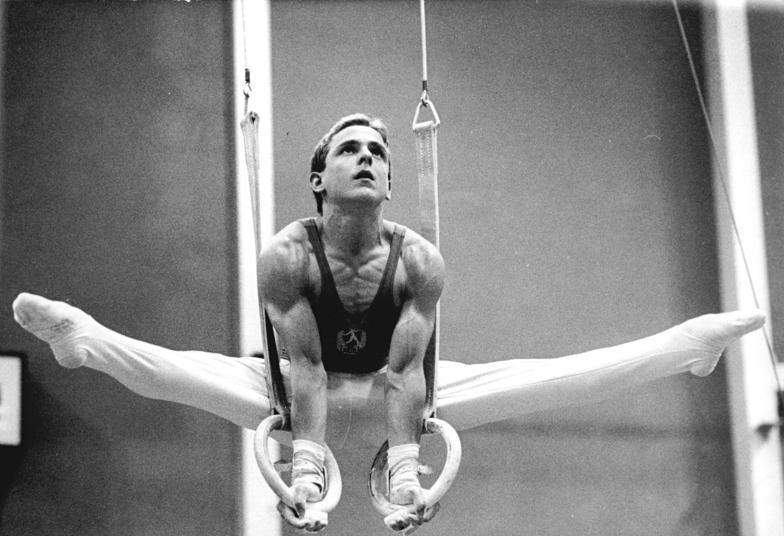1. Early Life and Education
Sven Tippelt's early life in Leipzig, East Germany, laid the foundation for his distinguished career in gymnastics and his subsequent academic and professional pursuits in physical education and physiotherapy.
1.1. Birth and Early Life
Sven Tippelt was born on June 3, 1965, in Leipzig, East Germany. He later grew to a height of 5.1 ft (1.56 m). During his competitive years, he was associated with the Sportclub Deutsche Hochschule für Körperkultur Leipzig and Sportverein Deilinghofen.
1.2. Education
Following his retirement from competitive gymnastics, Tippelt pursued and completed his physical education studies through distance learning in Leipzig. His academic work culminated in a thesis focused on biomechanics, demonstrating his deep understanding of the mechanics of living organisms, particularly human movement.
2. Gymnastics Career
Sven Tippelt's gymnastics career was marked by consistent performance and medal wins at the highest levels of international competition, including the Olympic Games and World Championships.
2.1. Olympic Games
Tippelt represented East Germany in two Summer Olympic Games, contributing significantly to his team's performance and earning individual medals.
2.1.1. 1988 Summer Olympics
At the 1988 Summer Olympics held in Seoul, Sven Tippelt achieved notable success. He was a key member of the East German men's artistic gymnastics team that secured a silver medal in the team all-around event. Individually, he earned two bronze medals: one on the parallel bars and another on the rings, showcasing his versatility and skill across different apparatuses.
2.1.2. 1992 Summer Olympics
Tippelt also participated in the 1992 Summer Olympics in Barcelona. With the German team, he contributed to a fourth-place finish in the team competition.
2.2. World Championships
Sven Tippelt consistently medaled at the World Artistic Gymnastics Championships, accumulating one silver and three bronze medals across three different championships.
2.2.1. 1985 World Championships
At the 1985 World Artistic Gymnastics Championships in Montreal, Tippelt earned a bronze medal as part of the East German team.
2.2.2. 1987 World Championships
During the 1987 World Artistic Gymnastics Championships held in Rotterdam, Sven Tippelt secured two bronze medals. He contributed to the team's bronze medal performance and also won an individual bronze medal on the parallel bars.
2.2.3. 1989 World Championships
Tippelt's final World Championship medal came at the 1989 World Artistic Gymnastics Championships in Stuttgart, where he helped the East German team achieve a silver medal.
2.3. Eponymous Skills
Sven Tippelt is recognized in the sport of gymnastics for an eponymous skill named after him, the 'Tippelt'. This skill is performed on the parallel bars and is described as a Moy piked with straddle backward to handstand. This recognition highlights his innovative contributions to the technical aspects of the sport.

3. Post-Retirement Career
After retiring from competitive gymnastics, Sven Tippelt successfully transitioned his focus from athletic performance to a professional career in healthcare, leveraging his academic background in physical education and biomechanics.
3.1. Professional Career
Instead of pursuing a coaching career in gymnastics, Tippelt chose to become a physiotherapist. He currently works at a rehabilitation clinic located in Bad Salzuflen, where he applies his expertise in human anatomy, physiology, and rehabilitation to help patients recover from injuries and improve their physical well-being.
4. Evaluation and Impact
Sven Tippelt's career demonstrates a remarkable blend of athletic excellence and a successful transition into a service-oriented profession, leaving a lasting impact both in the world of gymnastics and in his chosen field of physiotherapy.
4.1. Achievements and Contributions
Tippelt's significant achievements in gymnastics include multiple Olympic and World Championship medals. His three Olympic medals from the 1988 Seoul Games (one silver and two bronze) and four World Championship medals (one silver and three bronze) underscore his status as a top-tier athlete during his era. Furthermore, the naming of the 'Tippelt' skill on the parallel bars after him is a testament to his technical innovation and enduring legacy within the sport. His successful transition from a highly demanding athletic career to a professional role as a physiotherapist, utilizing his academic background in biomechanics, highlights his dedication to health and well-being beyond competitive sports.
| Competition | Event | Medal |
|---|---|---|
| Olympic Games | ||
| 1988 Seoul | Team | Silver |
| 1988 Seoul | Parallel bars | Bronze |
| 1988 Seoul | Rings | Bronze |
| World Championships | ||
| 1985 Montreal | Team | Bronze |
| 1987 Rotterdam | Team | Bronze |
| 1987 Rotterdam | Parallel bars | Bronze |
| 1989 Stuttgart | Team | Silver |